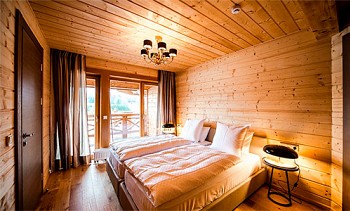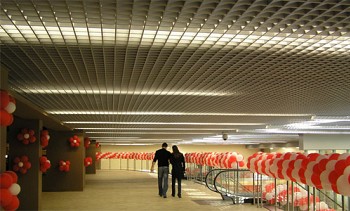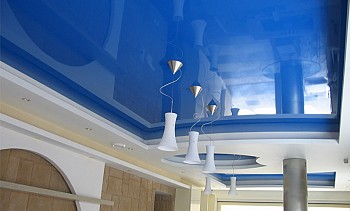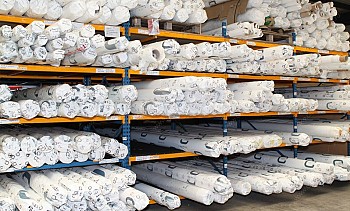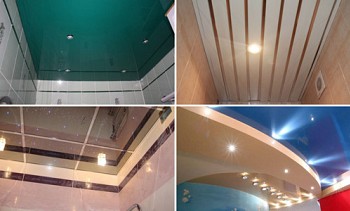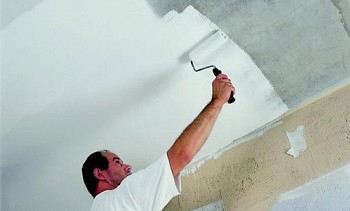Before choosing a ceiling, decide what types of ceilings are and what they have advantages and disadvantages. Ceilings vary in color, material texture, design and geometric shape. Only a ceiling with correctly selected parameters can visually enlarge a tiny room, add coziness to a huge hall, visually raise low ceilings. The correct and successful design will give your home warmth and comfort.
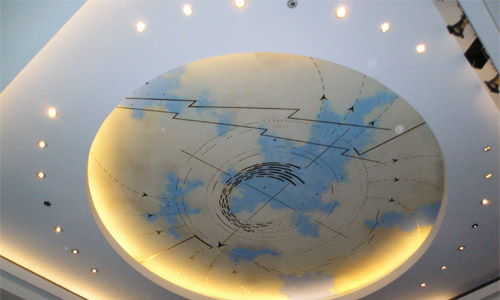
Content:
It is difficult for an ordinary consumer to independently understand the variety of modern materials and technologies for finishing ceilings. A competent approach will avoid mistakes in choosing a ceiling, taking into account the advantages and disadvantages of the ceiling coating.
Simple types of ceilings mounted and applied directly to the base
Of course, everyone knows the traditional methods of decoration: painting ceilings, whitewashing and wallpapering. Consider the technology of these finishing works.
Whitewash ceiling
The oldest, gradually losing its popularity, is considered a way to simply whitewash the ceiling. Method of execution: using a spray-gun or brush, a solution of lime or chalk is applied to the ceiling. To give a beautiful shade, various dyes are added to the solution.
The undoubted advantage is the simplicity of technology.
Disadvantages: it is difficult to wash old lime, increased soiling when performing finishing work, high labor intensity. Do not do without preliminary preparation: the surface of the ceiling should be perfectly smooth and clean.

Ceiling painting
When redecorating, they often choose the usual inexpensive color. As a coating, water-emulsion or water-dispersion paints of different colors can be used.
Advantages: simplicity of the technology of the work, the ability to use expensive or cheap paints.
Disadvantages: the work is characterized by increased complexity, after 2-3 years the painting must be repeated. Do not do without preliminary preparation: putty is used to level the surface. Only then can you start painting.

Wallpapering the ceiling
The undoubted advantages of wallpapering the ceiling:
- Cleanliness when performing work.
- When wallpapering the ceiling, you can hide cracks and defects in the seams on the ceiling. If ceiling painting is applied, these defects will remain visible.
- Long term of a good esthetic look: more than five years.
Ceiling wallpaper is denser than wall wallpaper. As a rule, they consist of glued two layers of thick paper. Foamed vinyl or beautiful embossing is applied on top. Due to the relief and thickness, the wallpaper perfectly hides all the irregularities and defects of the ceiling. The big advantage is that when using ceiling wallpaper, a perfectly prepared surface is not required. You can not wash off the old paint or close up irregularities. Everything is extremely simple and fast. The cost of ceiling wallpaper depends on the manufacturer, the quality and popularity of the collection. But there is a significant drawback - cheap wallpaper can not be washed.
Pasting the ceiling tiles
Beautiful adhesive ceilings can be created using tiles of various sizes. The most popular size is 500x500 mm. Tiles are made from extruded polystyrene foam. Using rectangular or square tiles, various original patterns can be made.
There is a large selection of adhesive tiles surface - smooth, rough, imitating woodcarving, beautiful stucco molding.If necessary, the tile is easily painted in any desired color, using a water-based paint. If there is a defect in the form of a significant difference between the plates, preliminary alignment of the ceiling surface is necessary.
Very easy care: wipe with a damp cloth or perfect cleaning with warm, soapy water. Since the cost of tiles is low, tiled ceiling decoration refers to an inexpensive way to create decorative ceilings.
Types of suspended ceilings, their advantages and disadvantages
False ceiling is an excellent option for hiding defects of the primary ceiling and created various communications. False ceiling can be of any color, texture, architectural form. By changing the design lighting, texture, shape and configuration of the suspension elements, you can create a unique ceiling design. But first, consult with experts and think over the issues of acoustics, lighting, ventilation, calculating the estimated total cost of the suspended ceiling, taking into account the selected lighting and the cost of installation work.
Drywall Ceilings
All suspended plasterboard ceilings are mounted on a galvanized steel frame. To perform complex suspended ceilings, the rails of the metal frame can be of any shape, even curved. After installation is completed, finishing of drywall boards is necessary. Plasterboard ceilings - a guarantee of excellent heat and noise insulation of your apartment.
They are recommended to be used only in high rooms. False plasterboard ceilings reduce the height of any room by 15-20 cm. Of course, you can come up with your own ceiling suspension design at a shorter distance. But for this, it is better to take the advice of competent specialists.
If the drywall is wet, it bends easily. And after drying it can take any given form. Therefore, it is widely used by designers to create original and complex geometric shapes: arch, dome, multi-level ceilings. A beautiful design of various configurations can be complemented by built-in lighting. False gypsum plasterboard ceilings are cheaper than stretch ones; therefore, they are deservedly popular.
Often they are combined with tension. Multilevel gypsum plasterboard ceilings are the most expensive, the most time-consuming to install, but allow you to implement interesting modern design solutions.
Cassette Ceilings
First, a frame structure is created. Then square cassettes are attached to it: thin aluminum or galvanized plates. A layer of powder paint of various colors can be applied to the front side of the plates. Optionally, you can choose smooth or rough plates for the design of the ceiling. Their surface may have notches, stripes or “worms”.
Undoubted advantages:
- easy installation;
- removed to wash quickly from dirt;
- can hide installed ventilation and air conditioning equipment;
- the ability to install a variety of lights;
- fireproof.
Among the shortcomings can be called low sound and sound insulation.
Mirror ceilings
One type of cassette ceiling is a beautiful mirrored ceiling. Only mirrors are used instead of metal panels. Thanks to the mirror view, you can visually increase the height, volume of the room, its area. If luminaires are additionally installed, their light will be originally reflected in the mirrors. In such a simple way, you can create a truly unique and unusual lighting.
The advantages of mirrored ceilings are durable, do not accumulate statistical stress, do not corrode, are absolutely safe and environmentally friendly. Simple installation, a variety of types of decorative finishes have made them very popular.
False ceilings
At first, the frame is made: metal or wooden. Drywall, decorative panels, and other sheet materials are attached to it.The details of the false ceiling are flexible, so you can create any complex curved surface.
The benefits of false ceilings:
- the ability to use lighting in a variety of design options;
- various types of lighting can be used;
- good sound and heat insulation.
Limitations:
- It can be used only for ceilings with small irregularities (1-2 cm).
- They are used for ceilings where communications are not planned. Recessed luminaires are not used.
- Necessarily requires a decorative finish.

Slatted ceilings
For non-residential cold rooms and for rooms of high humidity (for example, kitchen, bathroom), it is advisable to use rack ceilings. They do not deteriorate when exposed to moisture, cold, or temperature extremes, and therefore are very durable. They can be used even in rooms without heating. In addition, they are inexpensive and fireproof.
Slatted ceilings consist of special thin steel or aluminum narrow plates with a thickness of 0.5 mm. By hot drying, all parts are carefully varnished. The width of the plates is 10 - 15 centimeters, and the length can reach 4 meters. Slatted ceilings can have a wide variety of colors. But imitation of gilded, silver-plated or chrome-plated surfaces is considered the most popular. Optionally, rack ceilings can be made glossy or matte. For decoration, small decorative battens are often inserted between the main elements.
Stretch ceiling
A great choice for decorating living spaces are a variety of stretch ceilings. It is very simple to work with them, because they consist of a single piece of canvas. The material is heavy-duty vinyl polymers. They are manufactured in enterprises on the basis of accurate measurements for each individual room. Their thickness is 0.17-0.22 mm.
First, a rack frame is installed around the perimeter of the room. Then a polymer web is pulled over it. If desired, any pattern or pattern can be applied to such a ceiling. Stretch ceilings withstand significant loads, have antistatic properties.
The undoubted advantages of this type of ceiling:
- Durable and fire resistant.
- Excellent aesthetic appearance (about 10-15 years).
- Stretch ceilings do not require special constant care.
- It can be used in wet and dry rooms.
- The abundance of textures and colors will realize the most daring design ideas and fantasies.
Video: Armstrong suspended ceilings - photos of various kinds






















